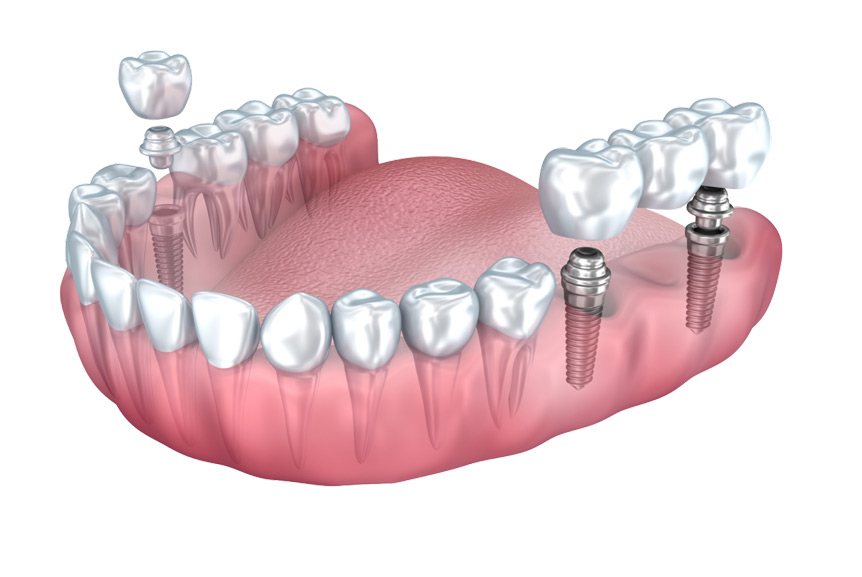For replacing a lost tooth or teeth, dental implants are by far the most common and best option. They have had a significant impact on dentistry in the last quarter-century or so.
A dental implant is a titanium post that is surgically implanted beneath the gum line into the jawbone to act as a tooth root.
Dental implant in Indore is perfectly done by Chauhans Dental Studio.
Types of Dental Implants?
Dental implants are metal devices that are surgically attached to the jawbone beneath the gums and used to support prosthetic teeth. Osseointegration is the process through which metal implants get attached to your bone (the bone fuses to the metal). This procedure offers a steady foundation on which you may rely when eating and speaking.
Endosteal and subperiosteal implants are the two primary types of implants recommended by the American Academy of Implant Dentistry. The optimal implant procedure for you is determined by the size, shape, and condition of your jawbone. Your dentist will be able to provide the best recommendation for you.
Endosteal implants
Endosteal implants are titanium cylinders (screws) or blades (broad, flat metal) surgically implanted into your jawbone where missing teeth are located. According to the American Academy of Periodontology, they are the most often used implants.
Before putting an abutment into the screw or blade, surgeons usually wait 4-6 weeks for your bone to Osseo integrate with the implant. That may seem like a long time to wait, but don’t panic — you may continue to eat, drink, and converse normally throughout this period.
Subperiosteal implants
Subperiosteal implants are placed on top of the jawbone and behind the gums. They bond to your jawbone over time through osseointegration. There are a few reasons why your dentist would prescribe them over endosteal implants, which are more often utilized. You may have bone loss in your jaw, or the form or condition of your jaw may prevent endosteal implants from being inserted surgically.
If subperiosteal implants are determined to be the best option for you, your oral surgeon will conduct two operations. Your gum line will be split open around the tooth loss location during the initial operation so that a mould of your jawbone may be produced. Sutures will be utilized to seal the incision until the implant is put on the bone in the second operation.
Are You a Candidate For Dental Implants
A person who is in good general and oral health is a suitable candidate for a dental implant. To support the implant, you’ll need enough bone in your jaw, and the best candidates will have healthy gum tissues that are free of periodontal disease.
Dental implant procedure
There are several phases to placing a dental implant. The following is a list of them:
Placing The Implant
The implant implantation operation may be made safe and pain-free thanks to advanced dentistry methods. Patients who are nervous about having a dental implant installed might request sedation from their dentist.
The process begins with the preparation of the jawbone, followed by a cutting to expose the bone for drilling holes by the surgeon. The holes are kept deep enough to allow the implant to be correctly installed and implanted deep into the bone, similar to the root.
In cases when the bone is weak or unable to sustain implant surgery, the doctor may recommend bone grafting. After that, the surgeon waits for the jawbone to heal before inserting the metal post.
The entire procedure, from beginning to end, might take several months, with the majority of that time spent recuperating and waiting for new bone to develop in the jaw.
After that, the patient is given a temporary crown, which is used to cover the gap and provide the desired cosmetic result. This crown may be removed for implant surgery, however it must be done when the bone has fully healed.
Healing
The jawbone will develop and connect with the surface of the dental implant throughout this phase. This procedure, also known as osseointegration, aids in providing a strong foundation for the new artificial tooth, just like roots provide for real teeth.
Depending on the quality and form of the bones, this procedure might take anywhere from 3 to 6 months. When patients have adequate bone structure, however, the surgery can be done in one day.
The second operation can then be scheduled, but only after the implants have merged with the bone. An x-ray will be taken by your dentists to determine whether the implant is suitable for the second operation.
Abutment Placement
It’s possible that you’ll need another surgery to implant the abutment, but only when you’ve fully recovered. This operation is generally performed under anesthesia in an outpatient environment.
The dentist will reopen the incision to connect the abutment to the dental implant during the operation. For 4 to 6 weeks, a temporary crown will be used to allow the gums around the abutment to recover. This type of crown is softer, which can help to cushion the implant and stress the soft tissues, which can aid in the healing process.
Placement Of Permanent Crown
The dentist will work on making the permanent crown seem exactly like your natural teeth in the following step. The surface texture, color, and anatomy will all be adjusted to mix in with the surrounding teeth.
To construct the crown, impressions of your mouth and remaining teeth are obtained. This allows a realistic-looking artificial tooth to be created. The crown, on the other hand, will not be put until the jawbone is sufficiently robust to support the new tooth.
Making a permanent crown, which will be glued or fastened to the Implant, takes less than 2 to 3 weeks.
Dental implant care




